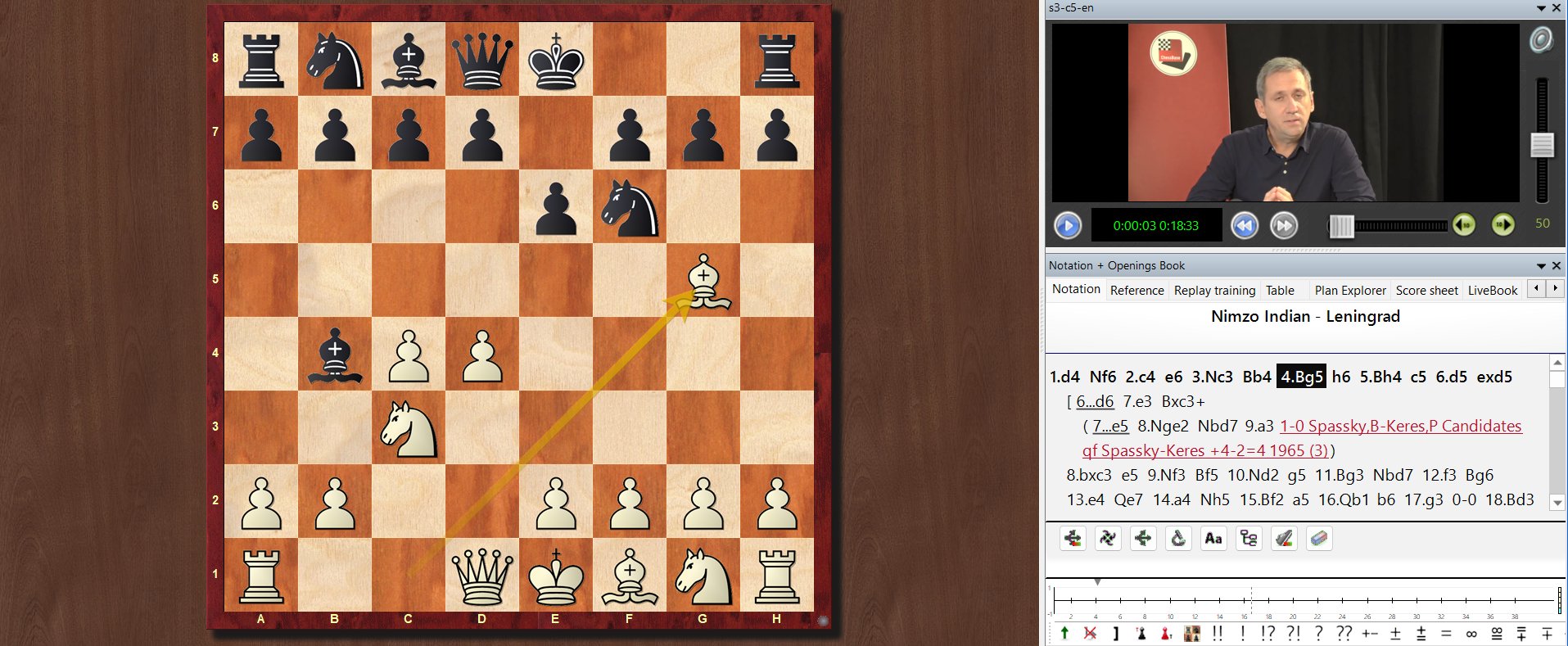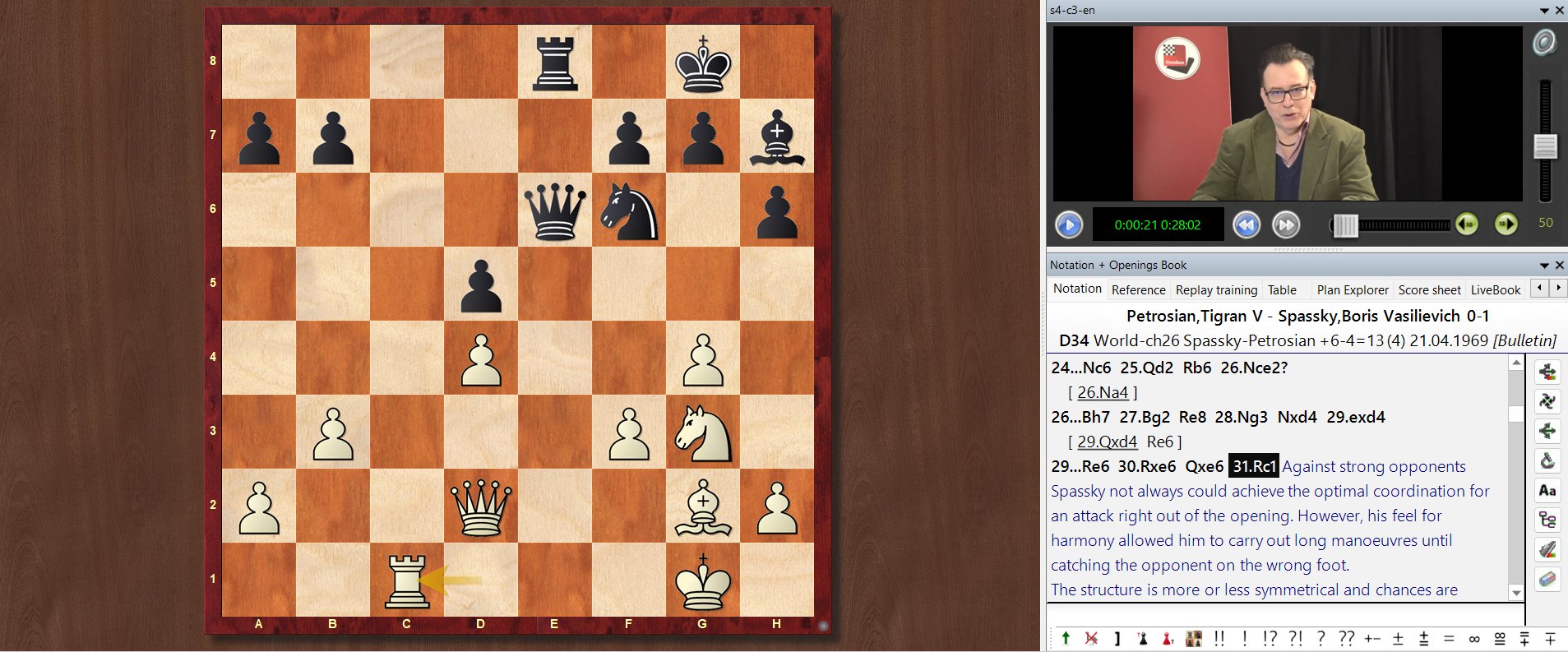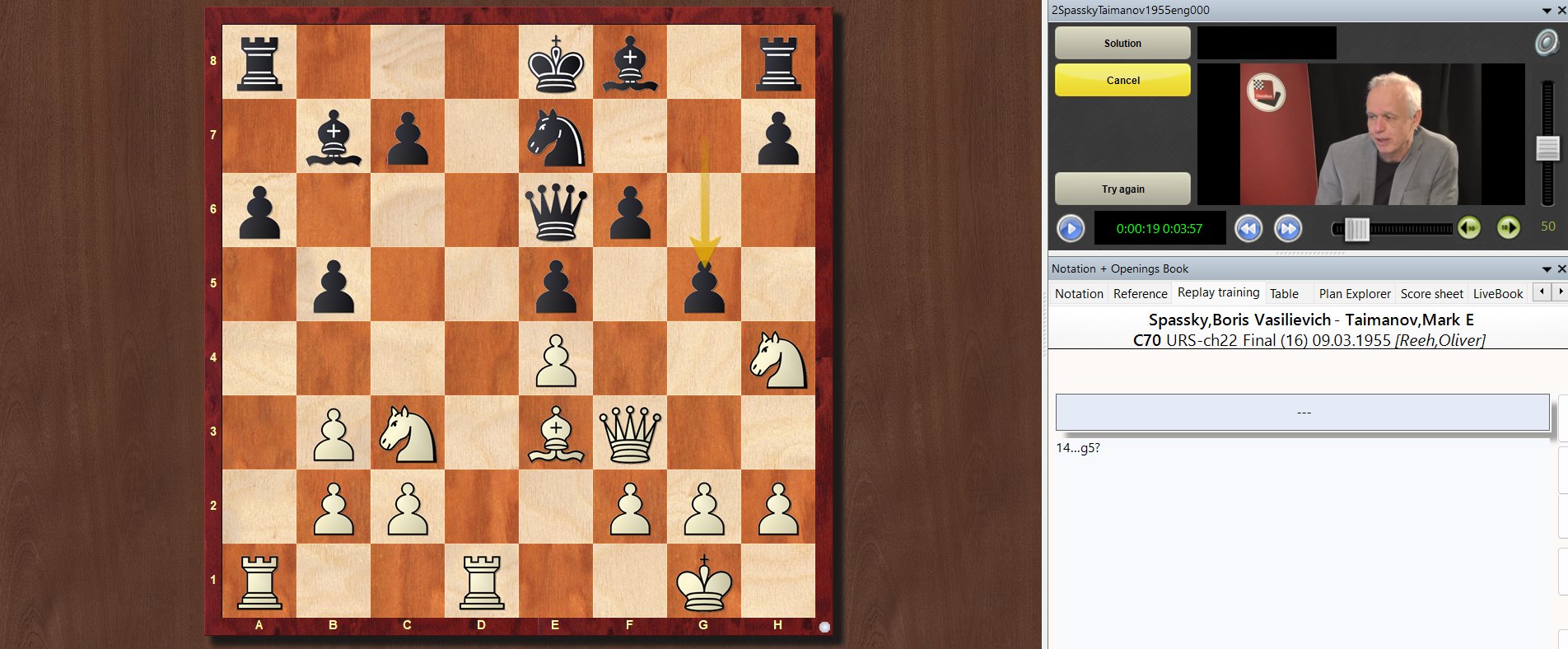The 17th part of the ChessBase Master Class series is devoted to the life and chess legacy of Boris Vasilyevich Spassky. If you are primarily interested in the former, you can jump straight into the long "short biography" by André Schulz, which does justice to Spassky's importance. A really successful overview of the most important stages of the chess genius who was born in Leningrad on 30 January 1937. However, this review will mainly focus on his chess legacy, which is presented to the viewer by four long-standing ChessBase experts in the chapters Opening, Strategy, Tactics and Endgame.
Opening
The opening repertoire of the pre-computer era tells us a lot about the playing style of the great masters. GM Dorian Rogozenco therefore devotes his chapter to Spassky's openings. After general considerations of the repertoire from the white and black perspective the former national coach of Germany and opening expert then turns his attention to the specialities of the Russian, who also played for Solingen in the German Bundesliga:

For example, in 30 games Spassky played the Leningrad Variation of the Nimzo-Indian (1.d4 Nf6 2.c4 e6 3.Nc3 Bb4 4.Bg5), which was considered a harmless line. But Spassky won 17 of his games with this variation and lost only one. Rogozenco explains why this variation was an important weapon for Spassky. The King's Gambit was sharper and Spassky was the only player to use it at the top level. The video tutorial includes impressive games played by Spassky against world class players such as David Bronstein, Yasser Seirawan and Anatoly Karpov.
The new ChessBase Opening Encyclopaedia 2024 - More content. More ideas.
After all, both the closed and the open Sicilian played an important role in the great career of the former World Champion. Rogozenco begins with a well-known game against Geller, which shows how Spassky used the Closed Sicilian as a dangerous strategic weapon. And finally Rogozenco completes the repertoire analysis by analysing Spassky's Spanish from both the white and black perspectives. Although Spassky has long since retired from the tournament scene, his games still provide plenty of material to improve our understanding of the opening. The included Opening Powerbook helps you to apply Rogozenco's analyses.
Strategy
View the introduction as Free video sample
"Botvinnik said that Boris Spassky was the first universal player in the history of chess and Botvinnik always meant such comments seriously", Mihail Marin begins his remarks on the strategic understanding of the chess legend who emigrated to Paris in 1976. According to Marin, Lasker, Capablanca and Alekhine were also universal, but Spassky reached a new level. Endgame expert Karsten Müller puts this down to Spassky's coach Bondarevsky. Although Spassky was known and feared as an attacker - which is emphasised throughout Master Class 17 - he also played a huge number of strategically impressive games.
The first DVD deals with the initial phase of the game, when the all the reigning principles can be crystalized into just one: DEVELOPMENT!
As mentioned at the beginning, the Romanian grandmaster and renowned coach outlines Spassky's favourite scheme: he builds up his pawns in the centre, manoeuvres a little with the pieces, then comes the attack. He rarely relies on specific combinations. Instead, he often sacrificed for a long period of activity and then manoeuvred patiently, waiting for the decisive moment. "He trusted that at some point there would be a tactical conclusion with a spatial advantage," Marin sums up. Marin's examples, spanning four decades, demonstrate the great and varied abilities of Spassky, who was World Champion from 1969 to 1972.
In 1966 Spassky lost his first World Championship match to Tigran Petrosian, three years later, in 1969, Spassky did better and won their second World Championship match. Both matches were a clash of styles. Marin sees Spassky's improvement in positional play as the reason for the challenger's success. Botvinnik wrote about Petrosian: "It is very simple with Petrosian - he has a feeling for which piece is in a bad position and he improves its position".

Spassky's win against Petrosian is a textbook example for rerouting pieces
According to Marin, this is exactly what Spassky did from move 31 onwards in the fourth game of the 1969 World Championship match - a highly instructive strategic example in which one black piece repeatedly clears the way for another in astonishing ways. It's easy to imagine the deep impression this positional masterpiece made on the defending champion.
The other examples, against Sokolov, Geller and Robatsch, are, in Marin's tongue-in-cheek comment, more in keeping with Spassky's style of play: He "actively built up the pieces in order to then throw them at the opponent's position and win". Of course, it's not quite as simple as that, and each of these examples is an impressive demonstration of Spassky's almost limitless intuition.
Tactics
The tenth World Chess Champion Boris Spassky had a special flair for dynamics and initiative, which made him an extremely feared attacker. Oliver Reeh, who had the pleasure of playing with Spassky for the SG Solingen for several years, has selected 24 combinatorial highlights from his games and provided them with interactive training questions. Victories from the opening, major triumphs against arch-rivals such as Korchnoi, Petrosian and Fischer, but also surprising knockouts from the German Bundesliga - you have the opportunity to relive it all from Spassky's perspective!
In almost every chess game there comes a moment when you just can't go on without tactics. So it is vital to train tactics properly - and Master Class Tactics offers you the perfect tool for this!
The chapter begins with an example from 1953, in which Spassky elegantly prevails against Vasily Smyslow in a duel between two future world champions. This is followed by a remarkable refutation of the unsuccessful Taimanov Spanish Defence. How does White win in an aesthetically pleasing way?

The winning move is Nxb5 – do you see why? (Solution at the end of the article)
Incidentally, it is particularly worthwhile for film buffs to take a look at the fifth tactical problem. This game by Spassky (with White against Bronstein, 1960) was used in the James Bond classic "From Russia with Love" - no wonder, given the King's Gambit action on the board ...
Endgame
According to GM Karsten Müller, Boris Spassky is a strong attacking player with excellent endgame skills. He has played against many legendary giants of the royal game. Enjoy these classics and his attacks while deepening your own endgame knowledge.
Grandiose endgames, for example against the queens of Korchnoi and Portisch, which could not be calculated at the board. In the first game he won brilliantly by shielding the king with his opponent's pawn, while in the Portisch game he missed the draw and had to concede defeat. Against Ribli, however, he managed a miraculous draw:

At that time the realisation matured, confirmed by the tablebases today, that queen's endings with g- and h-pawns are drawn if the defending king - as is the case here - is in a good enough position. Which of course has to be proven in practice. With f- and g-pawns, however, White should win.
Spassky has often shown that his knowledge and feeling of the endgame is almost limitless. Sometimes he even won drawn positions against the world's best players, such as Karpov - in a Queen and Knight vs. Queen endgame - or Judit Polgar - in a rook ending with an extra pawn, which Polgar could have held with active defence.
All endgame DVDs by Karsten Müller in one package! More than 70 hours of instruction! from "Basic knowledge for beginners" (volume 1) to "Practical Rook Endgames" (volume 8) to the ever-popular "Golden Guidelines of Endgame Play" (volume 14).
Summary
The Master Class series has found a worthy successor. Anyone who appreciates versatility will get their money's worth from each of the chapters. Boris Spassky's game was unique, and the analyses of the four masters give a sense of the seemingly limitless chess knowledge of the tenth World Champion. The authors also provide many insights into Spassky's exciting life. None of the chapters, which altogether last just over eight hours, are boring. Combined with the interactive features of the e-book, this masterclass is also engrossing from start to finish.
----
Solution of the tactical task:
With Nxb5 White destroys Black's defensive set-up. After ...axb5 (what else?) White exchanges the rooks, gives a check on h5 with his queen, and after ...Qf7 wins the black queen with Rd8+.



























